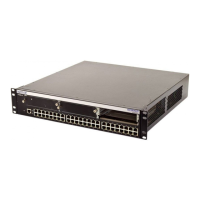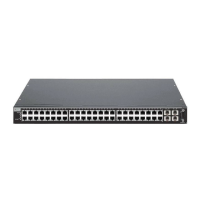passive-interface
27-16 IPv4 Advanced Routing Protocol Configuration
Parameters
Defaults
None.
Mode
Router configuration: C3(su)->router(Config-router)#
Example
This example shows how to configure a virtual link over transition area 0.0.0.2 to router ID
192.168.7.2:
C3(su)->router(Config)#router ospf 1
C3(su)->router(Config-router)#area 0.0.0.2 virtual-link 192.168.7.2
passive-interface
Use this command to enable passive OSPF on an interface or to set passive OSPF as the default
mode.
Syntax
passive-interface {default | vlan vlan-id}
no passive-interface {default | vlan vlan-id}
Parameters
area-id Specifies the transit area for the virtual link. Valid values are decimal values
or IP addresses. A transit area is an area through which a virtual link is
established.
router-id Specifies the router ID of the virtual link neighbor.
authentication-
key key
Specifies a password to be used by the virtual link. Valid values are
alphanumeric strings of up to 8 characters. Neighbor virtual link routers on
a network must have the same password.
dead-interval
seconds
Specifies the number of seconds that a router must wait to receive a hello
packet before declaring the neighbor as “dead” and removing it from the
OSPF neighbor list. This value must be the same for all virtual links attached
to a certain subnet, and it is a value ranging from 1 to 8192.
hello-interval
seconds
Specifies the number of seconds between hello packets on the virtual link.
This value must be the same for all virtual links attached to a network and it
is a value ranging from 1 to 8192.
retransmit-
interval seconds
Specifies the number of seconds between successive retransmissions of the
same LSAs. Valid values are greater than the expected amount of time
required for the update packet to reach and return from the interface, and
range from 1 to 8192. Default is 5 seconds.
transmit-delay
seconds
Specifies the estimated number of seconds before a link state update packet
on the interface to be transmitted. Valid values range from 1 to 8192. Default
is 1 second.
default Configure the default mode of operation for all interfaces.
vlan vlan-id Specifies the interface on which to enable passive OSPF mode.

